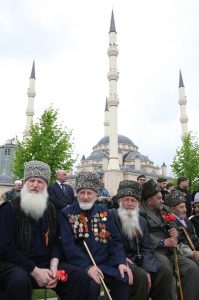
As unlikely as it may sound, Islam is the second largest beliefs in Russia after the Orthodox Christianity. The number of the Russians who profess this religion reaches 6.5% of the total population. The history of Islam in Russia is dated back from the time of Catherine the Great, the Empress of Russia from 1762 until 1796. During her time of being a ruler, there was the Orenburg Assembly that administered Islam throughout the country that became her vessel to support Muslim preachers and scholars.
There are several regions in Russia which the majority of the people are Muslim; like the republics of Bashkortostan and Tatarstan, Balkar, Circassia, Dagestan, Karachay, and two places that are still hot with social unrest; Chechnya and Ingushetia. About 10% are Shia Muslims and the rest are spread into the school of Sunni, Ahmadis, Naqshbandi, and Shadhili. The quota of Russian Muslims for hajj pilgrimage each year is 28,000 visas. Looking at these points, we can tell that there are a lot of Muslim communities in Russia. Let us now take a look at their name and facts.
1. Tatars
This is a term that refers to people who speak Turkic language and live in mostly in Russia and other post-Soviet countries. This community inherits Islam from Volga Bulgaria, the first Muslim state in Russia established in 922. The number of Muslim in Tatarstan is 38.80% from around 3.8 million populations. Today, there are more than 1000 mosques in the republic and a facility that produces 30 halal products. Tatarstan was once hosted an international Muslim film festival.
2. Kazakh
Larger than in Tatarstan, the population who embraces Islam in The Republic of Kazakhstan is up to 70.2% with the majority of Sunni Muslims. The religion was brought to the southern edge of Russia in the 8th century by Arabs. During the Soviet Union era, religious freedom was prohibited and the practice of Islam was also controlled and centralized. But after the Soviet era, mosques started to grow in Kazakhstan. In 2012, a new Khazret Sultan Mosque was unveiled by the President of Kazakhstan and it became the biggest worshipping place for Muslim in Central Asia.
3. Dargins
This is the term given to the inhabitants of the Daghestan, Russia. Before they were governed under the Soviet Union, their main language was Arabic and the system of education used was based on Islamic scholarship where they learned verses from the Quran. This caused the children of Dargins illiterate once the Soviet changed the system of education to Russian alphabet.
4. Circassian
The majority of this community is Sunni Muslim and originally from the North Caucasus region, an area in the southwest of Russia. In 1864 most of them were forced to leave their homeland and still can’t return until today. Only 10% of the Circassians still live within the border of Russia and spread in four different administrative areas; The Republic of Adygea, The Republic of Kabardino-Balkaria, The Republic of Karachay-Cherkessia, and Krasnodar Krai.
5. Laks
This community has a close relation to Dargins ethnically, culturally, and linguistically. They live in many different regions, but mainly in the basin of the upper Khatar River in Lak – hence the name. The people of Laks follow the Shafi school of Sunni Islam where they maintain the Sufi components that have been helping them to have a better relationship with the government. The Laks help each other to find jobs and build houses, resolve disputes, take care of burial, and so on. The peace is thick in this community.
6. Ingush
Although Ingushetia is the home of a lot of Russian Muslims, the republic is never surveyed or noted in the census because the condition of the region doesn’t allow it to happen. And so, the exact number of Muslims in Ingushetia can’t be measured exactly – but safe to say they are around one million people. The same with Laks, Ingush also goes with the Shafi school of Sunni Islam but they observe very little of the Sufi aspects of life. It is a sad fact that Ingushetia still remains as the poorest, most unstable region in Russia because of the ongoing conflict, corruption, and civil disorders.
7. Chechens
Chechnya is another Islamic region in Russia that doesn’t go under the census radar while the Muslim inhabitants are well around a million, just like Ingushetia. Akhmad Kadyrov, the leader of Chechens from 2000 until 2004 was a devout Muslim that he was also seen as a Mufti or a spiritual leader by his people. He was assassinated in May 2004 and his son, Ramzan Kadyrov, replaced his position. He continued the Sharia law across Chechnya by ordering women to be veiled in public and forbid alcohol consumption. He also supervised the building of one of Europe’s largest mosque. However, this law is confronted by women who choose to be liberated and respect their freedom. This sort of matter keeps coming to the surface in Chechnya which makes the republic stay in flame and avoided by Russians who don’t inhabit the region.
Although Islam is the second most dominant religion in Russia, its practice and observation are still challenged in several regions where extremists are still trying to take over the control and this issue actually happens in places with the most number of Russian Muslims. As for the minority communities like in Moscow, St. Petersburg, and other big cities in Russia, Muslims can practice in peace. Putin even once said that Orthodox Christianity is closer to Islam rather than Catholicism is. In Moscow, there are currently four mosques while all around Russia spread about 8,000 of them. Russian mosques are among the most beautiful ones in the world that a lot of Muslims from around the world would love to visit.
